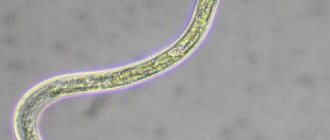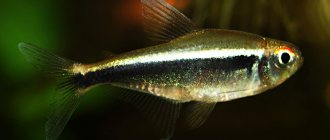Why did it become cloudy in the old and in the new, what is the difference?
Cloudiness in a new aquarium is normal and is due to the fact that the ecosystem has not yet stabilized.
It takes time for biological equilibrium to be established in it , when microorganisms are eaten by the inhabitants of the aquarium, and exactly as many bacteria are formed as necessary to maintain natural processes.
In an old aquarium, turbidity cannot appear just like that. And if this happens, it will not go away on its own until the cause is found out and measures are taken.
How to make a liquid crystal clear and transparent?
- Carefully monitor the hygiene of the tank and remove all contamination in a timely manner.
- Choose the right soil . Remember that sand can produce sediment, which can cause cloudiness. Also, do not fertilize the soil unless absolutely necessary. This can cause an algae outbreak, which is a highly undesirable inhabitant of your underwater world.
- Cover the aquarium with a special lid . This will help prevent dust from getting into the water, causing a cloudy film to appear.
Maintain the correct temperature. The water should not be too warm to prevent bacteria from multiplying in it, which can lead to algal blooms.
Cloudy water in an aquarium can cause frustration for every underwater lover. To prevent this from happening, follow the instructions above. In this case, nothing will stop you from admiring the beauty of your pets!
- Related Posts
- Top 11 reasons why aquarium water stinks. What to do if an unpleasant odor appears?
- Find out why water foams in an aquarium
- Has a film formed on the surface of the water in the aquarium? Not a problem, because there is a solution!
What does the smell of a swamp mean?
There are 6 reasons why an aquarium may start to smell:
- Irregular care. For beginners, the signal for the need to clean is the unpleasant smell. The longer you wait to clean your aquarium, the nastier it will smell.
- Insufficient filtration (lack of oxygen).
- Incorrect selection of plants.
- The uncleaned body of a dead fish or snail.
- Overfeeding of the inhabitants (excessive amounts of feces or fish disease due to overeating).
- A large number of "residents". Feces do not have time to decompose, forming a concentrated, foul-smelling mass.
Removing the swamp smell is simple: wash the aquarium and change the water. But if you don’t find out the reason, the next wash is coming in a week.
Why is the water in the aquarium cloudy?
An aquarium is a microcosm where organisms appear and die. It consists of a subtle interconnection of fish, plants and bacteria.
When creating a new aquarium, within a few days, a huge number of bacteria multiply excessively in the water. This leads to its clouding. This process is completely normal and natural. Before introducing your fish into an aquarium with new water, you just need to wait a few days until it clears itself. Due to lack of food, most bacteria will die out, and the biological balance of the water will normalize. In this case, changing the water is strictly prohibited, because it will also become cloudy. It is best to add some water from an old aquarium, where the balance has long been established. If this is not the case, it’s okay, the balance in the water will settle itself, it will just take more time.
Another reason for cloudy water may be overfeeding the fish. Excess food that your pets do not have time to eat sinks to the bottom and begins to rot. As a result, the water begins to deteriorate. In such an environment, the inhabitants of the aquarium cannot feel good, and a long stay in bad water will kill them.
If there are a large number of fish in the aquarium and, at the same time, poor filtration of the water, cloudiness occurs. The inhabitants of such an environment will certainly begin to poison their bodies with decay products, which will lead to their death.
The cause of cloudy water may be algae. There is a certain species that, when multiplied excessively, leads to a cloudy environment in the aquarium and at the same time emits an unpleasant odor. Another problem could be excess light or the accumulation of excess organic matter on the bottom, which stimulates the rapid growth of microscopic algae, resulting in water blooms. It becomes opaque with a greenish tint. If there is not enough light, the plants in the aquarium will turn brown and begin to rot, which will spoil the habitat for the fish and harm their health.
How to deal with cloudiness?
To instantly remove turbidity, you can use special products:
Chemical. For example, aquarium water conditioners Crystal Water Tetra Aqua, Sera Aquaria Clear, Formamed, AquaCons.
They really help clear water from turbidity, making it crystal clear.- Folk. Some people prefer to add activated carbon to the filter. It not only retains particles of dirt, but also disinfects the water. Another option: place foam sponges or microfiber cloths in the filter.
These remedies do not fight the cause of the appearance of turbidity, but only temporarily eliminate it. You cannot use chemicals all the time, so you need to find out the cause of the cloudiness.
Causes of cloudy water
Cloudy water in an aquarium is a nuisance that fish keepers all over the world encounter every day. As you know, water is something without which fish cannot exist, so the purity and parameters of the liquid play a key role in maintaining underwater inhabitants. Having noticed that the once beautiful and clean tank has turned into a container with dirty liquid, you should not panic - you should identify the reasons why the water in the aquarium becomes cloudy, and, based on the data obtained, proceed to a solution.
The appearance of cloudy water in an aquarium - reasons:
- Bacteria – if cloudy water appears in the aquarium after starting, then bacteria are to blame. This is absolutely normal, since biobalance has not yet been established in the tank. You need to give time for the liquid to clear itself, and then populate the living creatures. Without inhabitants of the underwater depths, bacteria will not be able to feed, and therefore live. It should be noted that in this case you cannot perform an update, since after the replacement the dregs will not go away.
- Soil – detection of cloudy water in an aquarium may be due to poor soil cleaning. If a launch is made and the owner has not washed the substrate, then dirt and dust will destroy the transparency of the liquid.
- Food – an aquarium can become cloudy if the owner overfeeds the fish and does not remove food debris from the container in a timely manner. As food remains decompose, they undergo rotting processes, as a result of which the water quickly becomes cloudy.
- Algae – cloudiness is often caused by parasitic algae, which, when multiplying, pollute the liquid. A clear sign that the tank has been chosen by uninvited guests is the strong smell of rot coming from the water and its green color.
- Changing the liquid - cloudiness can occur after replacement if the filling was done incorrectly: incorrect volume, careless pouring into the container.
- Overcrowding - the aquarium liquid becomes cloudy and dirty due to the dense population of the glass house. Fish, like any other creatures, leave behind waste products, which a good filter can handle.
In addition to these factors that can lead to cloudy water in the aquarium, poor-quality decorations or poor care of the artificial reservoir can be the culprits for the loss of cleanliness.
What to do for prevention?
Preventive measures to maintain aquarium cleanliness include following the basic rules for keeping fish.
You must first read the literature, and then choose the inhabitants and high-quality food for them , which should be poured with a measuring spoon at a specially designated time. It is also necessary to change the water on time and monitor the number of individuals in order to remove the corpses in a timely manner.
Sometimes the water becomes cloudy for particularly responsible owners. Therefore, you should not take the decorations out of the aquarium again to wash them.
There is no need to introduce an extra day of cleaning and scrape off the plaque that has just formed from the walls. It is not necessary to use the soil cleaner every day. Because turbidity in water is not only harmful, but also beneficial bacteria necessary to maintain the ecosystem.
Biological turbidity factors
Biological factors in the appearance of turbidity include the uncontrolled proliferation of fungi, bacteria and microorganisms. In the right quantity, they are necessary to maintain the normal state of the aquatic world, but with an excess of them, turbidity occurs. In an aquarium primarily populated with fish, there is no need to deal with cloudiness - this is the norm. The phenomenon goes away on its own within 3-5 days after the microcosm of the reservoir adapts to the new conditions. If you change the cloudy water, everything will happen again. A restart is required only if an unpleasant odor appears.
Biological turbidity can also occur in an established body of water if the owner overfeeds the pets and rarely cleans the bottom. Bacteria, fungi and microorganisms, having received additional food supply, will rapidly multiply, spoiling the appearance of the water. When there is too much feed, it rots, which increases the number of putrefactive bacteria; which cause not only cloudiness, but also rancidity of water. When the reservoir becomes cloudy for this reason, you should urgently change the water.
Treatment of sick individuals in a community aquarium is the reason why the water in the aquarium becomes cloudy and turns white. Medicines destroy not only pathogenic but also beneficial bacteria, which leads to an imbalance. Why should pets be treated in a separate container? You can only risk the water in an aquarium in case of an epidemic.
What does the color say?
Sometimes cloudy water in an aquarium takes on an uncharacteristic tone, which can indicate a factor initiating pollution of the aquatic environment:
- Green - if the muddy water in the aquarium has a grassy tint, this is evidence of the appearance of uninvited guests - tiny algae that color the liquid when they multiply. To restore the purity of the aquatic environment, it is necessary to remove green parasites.
- Brown - the dark color of the liquid is colored by decorative components made of wood, which exude humus and tannin into the water. To prevent this effect from happening in the future, you need to treat the scenery before diving. In addition to wooden products, peat gives the liquid a chestnut tint.
- White - a white liquid, as if covered with a veil, appears in an aquarium with fish due to the appearance of unicellular algae. In addition, the cause of lightening can be the use of medications.
- Gray - this shade is noted when the tank is highly contaminated, or due to the concentration of silicates and metals in the liquid. Special tests will help accurately diagnose the presence of substances.











